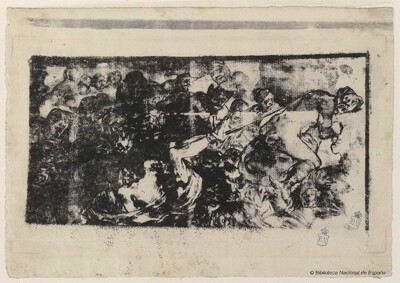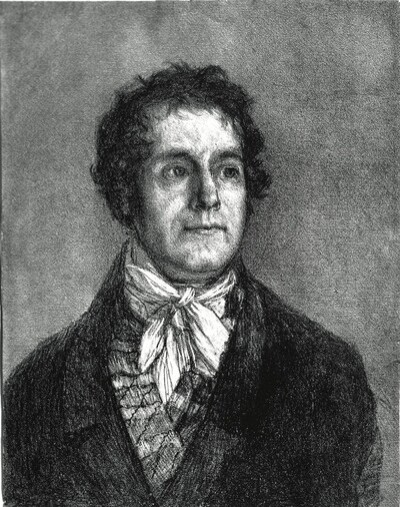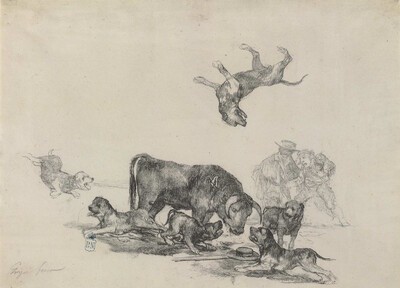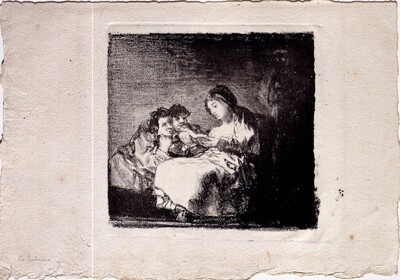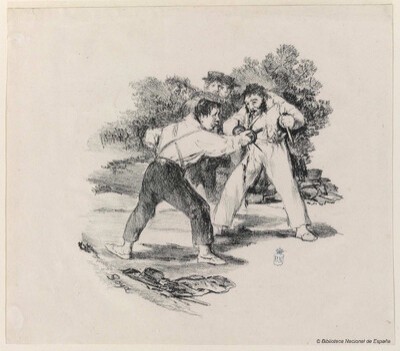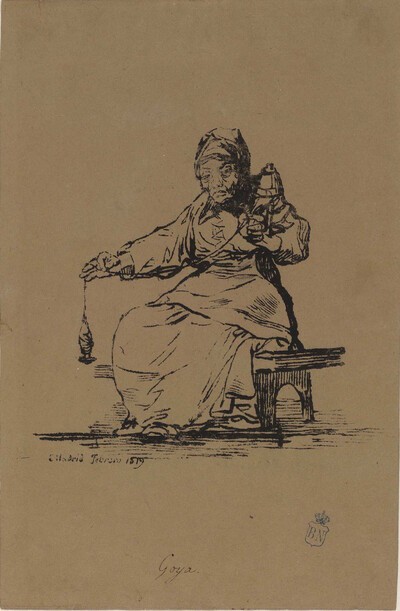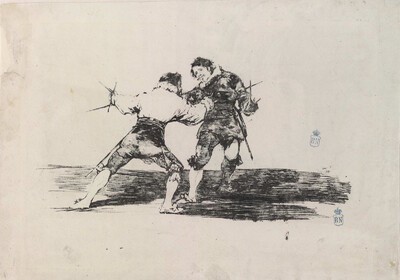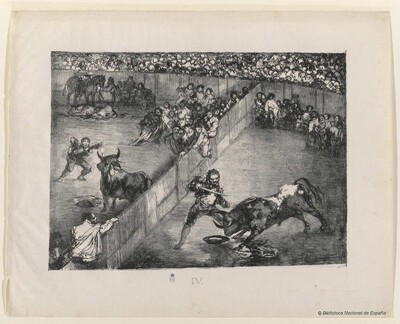- Cronología
- 1825
- Dimensiones
- 330 x 405 mm
- Técnica y soporte
- Piedra litográfica, lápiz y rascador, tinta negra, papel avitelado
- Reconocimiento de la autoría de Goya
- Documented work
- Ficha: realización/revisión
- 18 Feb 2011 / 24 May 2023
- Inventario
- 225
Goya (bottom left)
Déposé. (bottom edge, left)
Lith. De Gaulon. (bottom edge, right).
See The mourning
Together with Brave bull, Spanish entertainment, Bullfight in a divided ring and Bullfight, it forms part of the series "The Bulls of Bordeaux", printed by the printer Gaulon de Gaulon in his establishment in rue Saint Rémy in Bordeaux, of which there is only one proof in the Museum of Fine Arts in Bordeaux) was of one hundred copies, intended - as we know from a letter addressed to his friend Joaquín Ferrer - for sale to Spanish exiles in Bordeaux and in Spain, which is why the titles appear in Spanish.
See The mourning
In all the prints in the serie, the expressive drama is full, with deformations and an impetuous rhythm in the coposition. The contrasts of light and shade accentuate the fury violence of the scene. The clamour, agitation, bustle and barbarity of the bulls also have a point of censure towards all savagery. Goya sees the bullfighting festival as an exalted and distant reminder of Spain. Despite being a work by an octogenarian artist, it is full of youthful verve, vigour and enthusiasm.
In the first print of the serie, the protegonist is a mixed-race bullfighter of unknown origin (he could be Argentinian or Peruvian), famous for his spectacles in which he would saddle or ride bulls for bullfighting, whom Goya depicted in prints of Bullfighting such as number 23, Mariano Ceballos, aka El Indio, kills the bull from his horse, number 24 The same Ceballos riding a bull on another bull that broke the horns in the bullring of Madrid and the letter J, Mariano Ceballos riding a bull breaks half spears. In this case, he appears riding a black bull, previously roped and saddled, ready to thrust a lancing sword into another animal with a lighter coat. He creates a circle of bullfighters and spectators who, thrilled by the spectacle, crowd around the bullfight. A central circle of light gives luminosity and contrast to the scene, leaving the audience between light and shadow. With the scraper he draws lines with which he outlines the figure of the bull to give it movement.
-
Goya. Das Zeitalter der Revolucionen. Kunst um 1800 (1980 – 1981)Hamburger KunsthalleHamburg1980cat. 263
-
Goya: toros y torerosEspace Van GoghArles1990displayed also at Academia de Bellas Artes de San Fernando, Madrid, consultant editor Pierre Gassier.cat. 68
-
Ydioma universal: Goya en la Biblioteca NacionalBiblioteca NacionalMadrid1996from September 19th to December 15th 1996
-
Goya: Order and disorderMuseum of Fine ArtsBoston2014cat. 102
-
Goya engravings and lithographs, vol. I y II.OxfordBruno Cassirer1964p. 425, cat. 283
-
Vie et ouvre de Francisco de GoyaParísOffice du livre1970p. 363, cat. 1707
-
Goya, Das Zeitalter de Revolutionen. 1789-1830HamburgPrestel-Verlag Münche und Hamburger Kunsthalle1980p. 297
-
Origen de la litografía en España. El real establecimiento litográficoMadridFabrica Nacional de Moneda y Timbre1990p. 363, cat. 34
-
Goya, toros y torerosMadridMinisterio de Cultura, Comunidad de Madrid1990p. 146
-
Catálogo de las estampas de Goya en la Biblioteca NacionalMadridMinisterio de Educación y Cultura, Biblioteca Nacional1996p. 260, cat.408
-
Goya. Estampas. Grabado y litografíaBarcelonaElecta ediciones2007pp. 40-44, 342 y 374, núm. 278
-
Goya: Order & DisorderBostonMuseum of Fine Arts Boston Publications2014p. 172
-
Goya. In the Norton Simon MuseumPasadenaNorton Simon Museum2016p. 138

